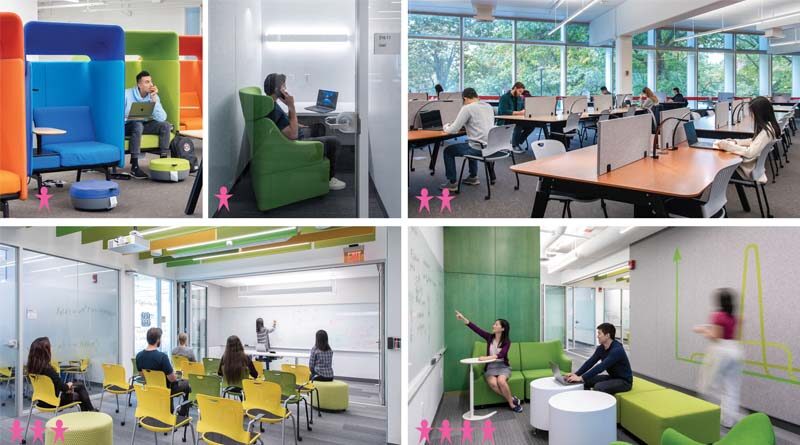Designing for Interior Flexibility: COVID-19 and Beyond
Harvard University’s Computer Science / Statistics Data Science Lab (CS/SDS Lab) and the Cabot Science Library Second Floor
By Juliet Chun
Today’s students desire a variety of study spaces, choosing among diverse scenarios whether working together or alone. COVID-19 has amplified the need for these options due to crucial six-feet-apart social distancing. As higher education projects comprising interior fit-outs or renovations proliferate, how can we integrate this type of flexibility within a building’s existing footprint? In the case of Harvard University’s Computer Science / Statistics Data Science Lab (CS/SDS Lab) and the Cabot Science Library’s second floor—two projects with different programs and sets of existing conditions—a deeper understanding of social interaction levels informed our firm’s renovation of their array of public and private spaces in a variety of configurations.
Both projects, located in the 1973 Josep Lluis Sert-designed Science Center, a modern landmark, introduce natural daylight and utility into the original precast building. Because of the existing structure’s constraints, careful planning was required to ensure maximum malleability. First, transparency and electricity were introduced throughout, providing reimagined settings for the spatial configurations to come. Glass partitions were inserted where separation was needed, allowing daylight to penetrate many of the interior rooms. Abundant electrical outlets were added to amplify student workspace and furniture arrangement options. This environment provided the backdrop for further study of program placement and evolving social interactions that led to our design.
Our design team developed a framework of “social interaction intensity” to help define spaces that support a clear range of density. Using four levels of interaction as a guide, the team identified distinct areas for level 1 (studying alone), level 2 (quietly working together), level 3 (group meetings), and level 4 (casual conversations). These areas were deemed appropriate for each of the project’s differing programs. The CS/SDS Lab now comprises a variety of shared open spaces, shared offices, and private offices. Users here typically work individually on their laptops or collaboratively together over glass writing boards and lively debates. The Cabot Science Library second floor has several group study rooms surrounding one large, central area. Separated by glass from the basement and first floors, this space provides a quiet area where students can work within a larger study context.
Based on typed and planned location of furniture, specific areas of interaction were identified within each project. Areas in remote locations of the plan were tagged as level 1 (places for quiet study), and rooms and spaces near entrances or circulation were tagged level 4 (places for casual exchange). Furniture also played a part in this plan: pod-like, single-seated furniture indicates a desire to be alone (level 1), table and chairs provide a place to quietly work together (level 2), individual soft seating invites a quick “hello” (level 3), and group lounge furniture fosters conversation (level 4). These options give students the flexibility they desire day-to-day.
Focusing on a variety of interaction levels also allowed the team to carefully incorporate a range of social densities and create spaces that were inherently flexible and adaptable to multiple uses. Two foldable glass wall partitions were used in the CS/SDS Lab to expand the work area when, biannually, a hackathon event takes place. For all other times, the space can be broken into three areas: the kitchenette, work area, and small conference room—spaces that inherently need and provide different types of social exchange.
By recognizing and designing for interaction levels, one can also begin to understand the implications of these social densities in relation to COVID-19. Spaces that were once designed for open public interaction can be easily modified for social distancing by removing chairs and rearranging tables. For the Cabot Science Library’s second floor, the plan allows for multiple situations: a one-way seating direction or staggered seating for individual distancing, group study rooms for those already living together to study together while being distanced from others, and taller table partitions that can replace existing partitions if added security is needed. Even highly public areas designed for group discussion such as those in the CS/SDS Lab can be re-arranged to accommodate fewer people with appropriate social distance observed.
By designing a malleable architectural framework that allows for flexibility, using social interaction research and levels as a guide, we can collectively create interior spaces that accommodate many configurations and shared settings, meeting today’s COVID-19 academic challenges and tomorrow’s student needs.
Juliet Chun, AIA, is an architect with Leers Weinzapfel Associates.

